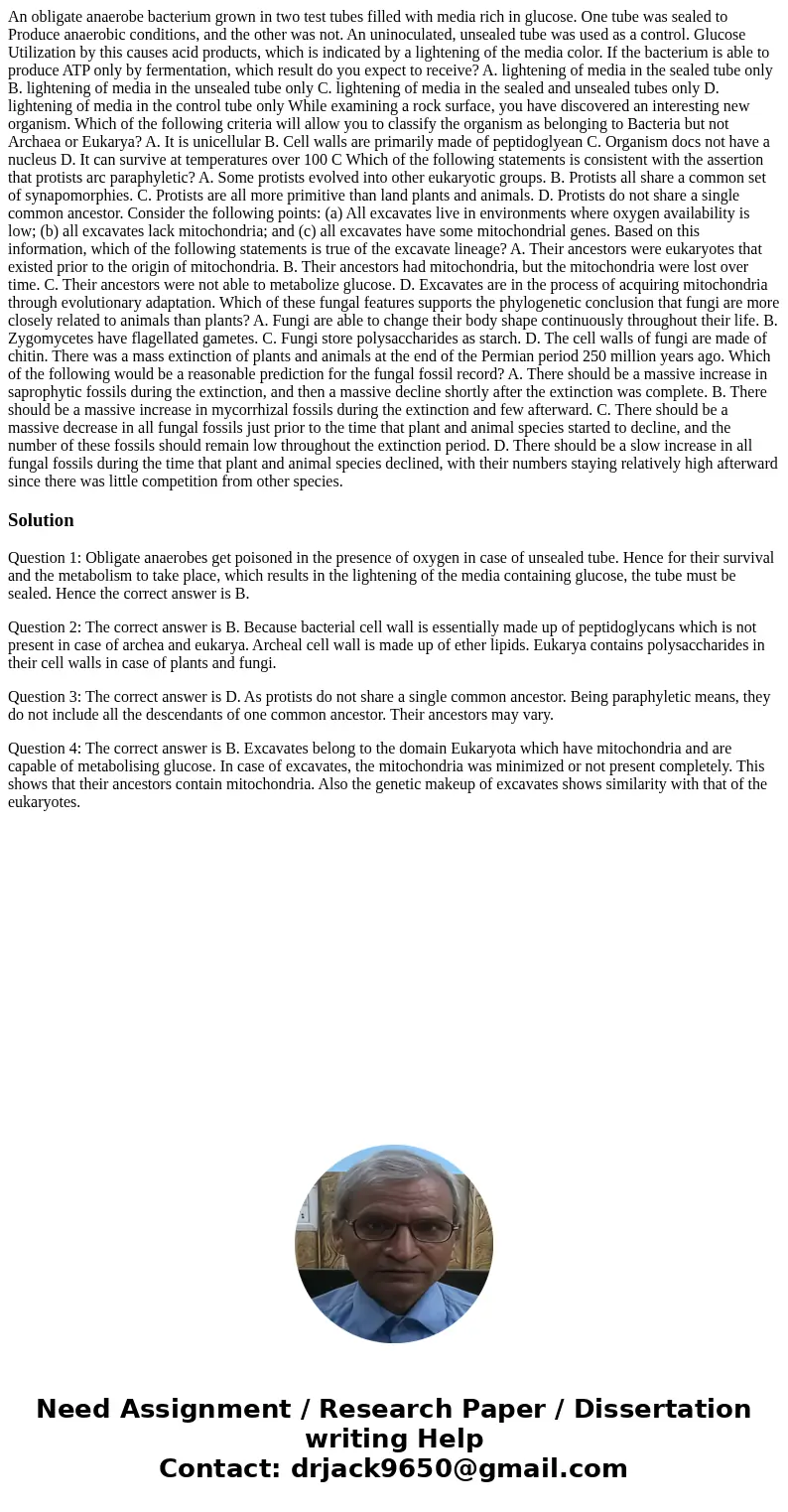An obligate anaerobe bacterium grown in two test tubes filled with media rich in glucose. One tube was sealed to Produce anaerobic conditions, and the other was not. An uninoculated, unsealed tube was used as a control. Glucose Utilization by this causes acid products, which is indicated by a lightening of the media color. If the bacterium is able to produce ATP only by fermentation, which result do you expect to receive? A. lightening of media in the sealed tube only B. lightening of media in the unsealed tube only C. lightening of media in the sealed and unsealed tubes only D. lightening of media in the control tube only While examining a rock surface, you have discovered an interesting new organism. Which of the following criteria will allow you to classify the organism as belonging to Bacteria but not Archaea or Eukarya? A. It is unicellular B. Cell walls are primarily made of peptidoglyean C. Organism docs not have a nucleus D. It can survive at temperatures over 100 C Which of the following statements is consistent with the assertion that protists arc paraphyletic? A. Some protists evolved into other eukaryotic groups. B. Protists all share a common set of synapomorphies. C. Protists are all more primitive than land plants and animals. D. Protists do not share a single common ancestor. Consider the following points: (a) All excavates live in environments where oxygen availability is low; (b) all excavates lack mitochondria; and (c) all excavates have some mitochondrial genes. Based on this information, which of the following statements is true of the excavate lineage? A. Their ancestors were eukaryotes that existed prior to the origin of mitochondria. B. Their ancestors had mitochondria, but the mitochondria were lost over time. C. Their ancestors were not able to metabolize glucose. D. Excavates are in the process of acquiring mitochondria through evolutionary adaptation. Which of these fungal features supports the phylogenetic conclusion that fungi are more closely related to animals than plants? A. Fungi are able to change their body shape continuously throughout their life. B. Zygomycetes have flagellated gametes. C. Fungi store polysaccharides as starch. D. The cell walls of fungi are made of chitin. There was a mass extinction of plants and animals at the end of the Permian period 250 million years ago. Which of the following would be a reasonable prediction for the fungal fossil record? A. There should be a massive increase in saprophytic fossils during the extinction, and then a massive decline shortly after the extinction was complete. B. There should be a massive increase in mycorrhizal fossils during the extinction and few afterward. C. There should be a massive decrease in all fungal fossils just prior to the time that plant and animal species started to decline, and the number of these fossils should remain low throughout the extinction period. D. There should be a slow increase in all fungal fossils during the time that plant and animal species declined, with their numbers staying relatively high afterward since there was little competition from other species.
Question 1: Obligate anaerobes get poisoned in the presence of oxygen in case of unsealed tube. Hence for their survival and the metabolism to take place, which results in the lightening of the media containing glucose, the tube must be sealed. Hence the correct answer is B.
Question 2: The correct answer is B. Because bacterial cell wall is essentially made up of peptidoglycans which is not present in case of archea and eukarya. Archeal cell wall is made up of ether lipids. Eukarya contains polysaccharides in their cell walls in case of plants and fungi.
Question 3: The correct answer is D. As protists do not share a single common ancestor. Being paraphyletic means, they do not include all the descendants of one common ancestor. Their ancestors may vary.
Question 4: The correct answer is B. Excavates belong to the domain Eukaryota which have mitochondria and are capable of metabolising glucose. In case of excavates, the mitochondria was minimized or not present completely. This shows that their ancestors contain mitochondria. Also the genetic makeup of excavates shows similarity with that of the eukaryotes.

 Homework Sourse
Homework Sourse